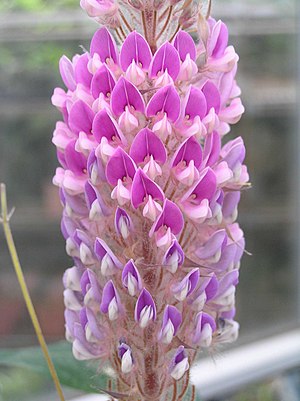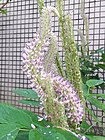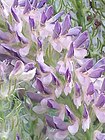Note: This is a project under development. The articles on this wiki are just being initiated and broadly incomplete. You can Help creating new pages.
Uraria crinita
Uraria crinita is an erect perennial plants with stems up to 2 metres tall that become woody at least at the base. The plant is often gathered from the wild and used locally as a medicinal herb. It is also grown as a green manure and is sometimes grown in gardens as an ornamental.
Contents
[hide]- 1 Uses
- 2 Parts Used
- 3 Chemical Composition
- 4 Common names
- 5 Properties
- 6 Habit
- 7 Identification
- 8 List of Ayurvedic medicine in which the herb is used
- 9 Where to get the saplings
- 10 Mode of Propagation
- 11 How to plant/cultivate
- 12 Commonly seen growing in areas
- 13 Photo Gallery
- 14 References
- 15 External Links
Uses
Dysentery, Diarrhoea, Enlarged spleen, Liver, Tumours, Fistulae.[1]
Parts Used
Chemical Composition
A new isoflavanone, (3S)-5,7-dihydroxy-2′,3′,4′-trimethoxy-6,5′ diprenylisoflavanone (1) and eight known compounds including five flavones (2–6), two triterpenes (7–8) and a steroid (9) were isolated from the whole plant of Uraria crinita (Leguminosae).[2]
Common names
| Language | Common name |
|---|---|
| Kannada | |
| Hindi | |
| Malayalam | |
| Tamil | |
| Telugu | |
| Marathi | |
| Gujarathi | |
| Punjabi | |
| Kashmiri | |
| Sanskrit | |
| English |
Properties
Reference: Dravya - Substance, Rasa - Taste, Guna - Qualities, Veerya - Potency, Vipaka - Post-digesion effect, Karma - Pharmacological activity, Prabhava - Therepeutics.
Dravya
Rasa
Guna
Veerya
Vipaka
Karma
Prabhava
Habit
Identification
Leaf
| Kind | Shape | Feature |
|---|---|---|
Flower
| Type | Size | Color and composition | Stamen | More information |
|---|---|---|---|---|
| {{{5}}} |
Fruit
| Type | Size | Mass | Appearance | Seeds | More information |
|---|---|---|---|---|---|
Other features
List of Ayurvedic medicine in which the herb is used
Where to get the saplings
Mode of Propagation
How to plant/cultivate
Requires a well-drained soil.[4]
Commonly seen growing in areas
Dry grassland, Open forest, Waste places, Roadsides, Sandy areas.
Photo Gallery
References
- Jump up ↑ Indian Medicinal Plants by C.P.Khare
- Jump up ↑ Chemical constituents
- Jump up ↑ [Morphology]
- Jump up ↑ Cultivation
External Links
- [ ]
- Ayurvedic Herbs known to be helpful to treat Dysentery
- Ayurvedic Herbs known to be helpful to treat Diarrhoea
- Ayurvedic Herbs known to be helpful to treat Enlarged spleen
- Ayurvedic Herbs known to be helpful to treat Liver
- Ayurvedic Herbs known to be helpful to treat Tumours
- Ayurvedic Herbs known to be helpful to treat Fistulae
- Herbs with Whole plant used in medicine
- Habit - Perennial
- Index of Plants which can be propagated by Seeds
- Herbs that are commonly seen in the region of Dry grassland
- Herbs that are commonly seen in the region of Open forest
- Herbs that are commonly seen in the region of Waste places
- Herbs that are commonly seen in the region of Roadsides
- Herbs that are commonly seen in the region of Sandy areas
- Herbs






